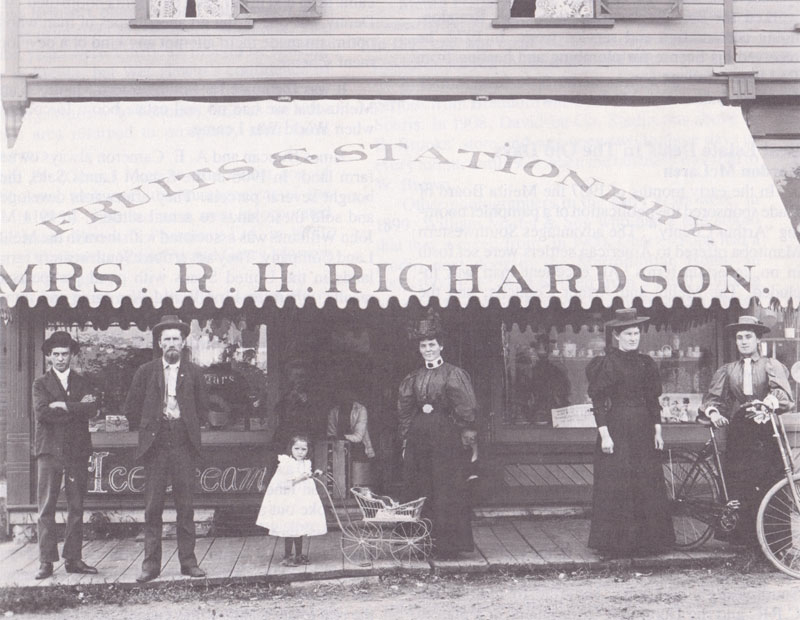

|
We Made Melita
Merchant
Shop
Keeper Mrs. R.H. Richardson
|

Mrs. Richardson, second from
the right, in front of one
of Melita’s first retail operations. Just in case there was any doubt
about who was in charge, her name is prominently displayed.
|

Among the very early pioneers of this district are Mr.
and Mrs. R. H.
Richardson. Mr. Richardson came to Manitoba in the spring of 1882 from
Wakefield in the province of Quebec, about 22 miles from the City of
Ottawa. For about 12 years previous to coming to Manitoba he had worked
at the carriage making business. In the early days in this country, his
knowledge and
skill with tools proved of great value. During the summer of 1882 he
worked at carpentering in Winnipeg and late in the fall came out to
this district, and selected a homestead, two miles from the site of
what is now Melita. He then returned to the east, but in the spring of
1883 came west again accompanied by Mrs. Richardson.
The Richardsons moved to the new townsite of Melita before the railway
had arrived and started two businesses; a carriage shop and a makeshift
fruit and vegetable stand. 1891 a more permanent structure housed Mrs.
Richardson’s growing Fruit and Vegetable business and served as a
residence as well. The East End Fruit Store was operated by Mrs.
Richardson until 1901.
Adapted from Our First Century, page 56, 699, 386
A Day in the Life of a General Store
The small-town general store, also known as mercantiles and emporiums,
were essential aspect of commercial activity in small-town life, and
saw their heyday in the period between 1880 and 1930.
These establishments served the rural populations of small towns and
villages and the farmers in the surrounding area. Besides selling dry
goods, farming equipment and other supplies, they sometimes also served
as the local post office, drugstore and undertaker. They were also a
popular meeting place for socializing and news gathering.
The storekeepers stocked their establishments with merchandise procured
from salesmen who represented wholesale houses and manufacturers found
in larger cities. Merchandise selections were often large and varied,
though most of the items available for sale were those of necessity. As
people and businesses prospered in the economy during the 1890s more
luxury items were introduced into the store inventories. The expansion
of the railroads, the advent of mass production and technological
advances such as the refrigerated railcar to transport perishable foods
all combined to escalate the national distribution and variety of goods
that were available in the stores.
Most of the wall space in a general store was taken up with shelving to
store and display for the merchandise; likewise the floors were crowded
with barrels, wooden boxes and crates. Store counters were good for
holding display cases for the smaller items, a coffee grinder, scales
and a cash register. Many stores had a display window or two in the
front of the building. Cellars, basements and second floors were used
for storage of merchandise and displays.
The proprietors of general stores knew almost all of their customers
and they were adept at anticipating their needs. It was not uncommon
for articles to be sold on credit or for payment to be accepted in the
form of bartered goods.
What were some of the items that could be found in a general store?
Food and consumables included coffee beans, spices, baking powder,
oatmeal, flour, sugar, tropical fruit, hard candy, eggs, milk, butter,
fruit and vegetables, honey and molasses, crackers, cheese, syrup and
dried beans, cigars and tobacco.
Dry goods included bolts of cloth, pins and needles, thread, ribbon,
silk, buttons, collars, undergarments, suspenders, dungarees, hats and
shoes.
Essential items such as rifles, pistols, ammunition, lanterns, lamps,
rope, crockery, pots and pans, cooking utensils and dishes, farm and
milking equipment and even coffins could be found.
The apothecary sections of the stores were well represented with a
surprisingly large number of patent medicines, remedies, soaps and
toiletries and elixirs.
Many old general stores were dark and, depending upon the geographical
location, probably damp and humid. Cast iron stoves heated the stores
during the cold months. Many of the stores may have been muddy and
dusty, given the foot traffic from unpaved roads.
|
|





